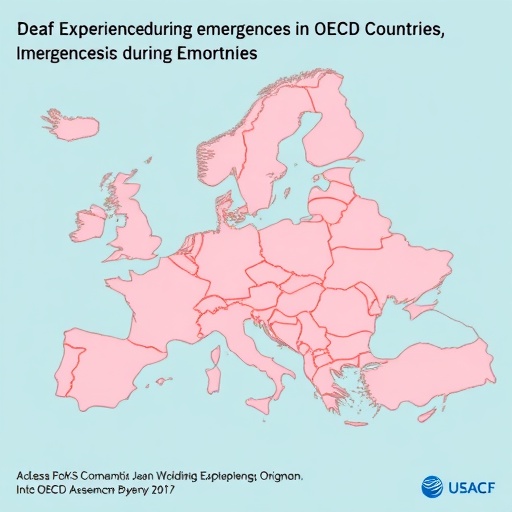In the realm of disaster management and emergency response, inclusivity remains a pivotal yet often overlooked principle. A recent comprehensive study published in the International Journal of Disaster Risk Science meticulously explores the experiences of individuals who are deaf or hard-of-hearing (DHH) during emergencies across OECD countries. By delving into their lived realities, the research exposes critical gaps in current emergency communication strategies and highlights the urgent need for tailored interventions that ensure equitable access to vital information in times of crisis.
Effective communication serves as the backbone of disaster preparedness and response. However, conventional emergency messaging systems predominantly rely on auditory signals such as sirens, public address systems, and verbal announcements, which inherently challenge people with hearing impairments. This study illuminates the multidimensional barriers faced by DHH individuals, ranging from inaccessible alerts to insufficient emergency broadcasts, resulting in delayed reactions and heightened vulnerability during critical incidents.
Analyzing policies and practices implemented across OECD member nations, the researchers identify a pattern of inconsistent inclusion of DHH communities in emergency planning processes. Despite advancements in technology and growing awareness of disability rights, emergency protocols frequently lack standardized mechanisms to accommodate the diverse communication needs within this demographic. This systemic oversight not only undermines the effectiveness of response efforts but also exacerbates feelings of isolation and insecurity among DHH populations during crises.
One of the key findings revolves around the utilization of sign language interpreters and visual communication tools as essential components of effective emergency communication. The study underscores that real-time sign language interpretation during televised emergency broadcasts significantly enhances comprehension and response among DHH viewers. Nonetheless, resource limitations and a lack of regulatory mandates often preclude the consistent inclusion of interpreters, thereby impeding the flow of critical information.
The integration of technology offers promising avenues to bridge these communication gaps. The research highlights the potential of captioning services, mobile alert applications with vibration and visual cues, and real-time text messaging as vital adjuncts to traditional emergency warning systems. However, deployment and adoption vary widely across countries, reflecting disparities in infrastructure, funding, and policy prioritization. Bridging this digital divide is crucial to fostering resilience in DHH communities.
Beyond technological solutions, the study emphasizes the paramount importance of community engagement and participatory planning. DHH individuals, advocacy groups, and stakeholders must be actively involved in designing and testing emergency communication strategies to ensure cultural and linguistic appropriateness. This inclusive approach not only enhances the relevance of communication but also empowers individuals through participatory ownership of preparedness initiatives.
The psychological impact of emergencies on DHH populations also commands attention. Isolation, misinformation, and delayed alerts contribute to increased anxiety and distrust toward emergency systems. The study advocates for mental health support services that are accessible and culturally sensitive, ensuring that coping mechanisms are available in both the immediate aftermath and long-term recovery phases.
An interdisciplinary approach emerges as an overarching recommendation, one that harmonizes insights from public health, communication technology, linguistics, disability studies, and policy analysis. Coordinated efforts promise to yield holistic frameworks that are adaptable to diverse emergency contexts, including natural disasters, pandemics, and technological accidents. These frameworks should be dynamic to accommodate evolving technologies and shifting demographic patterns among DHH communities.
Moreover, legal frameworks must be strengthened to mandate inclusive emergency communication practices. Drawing from successful case studies within the OECD, the report highlights jurisdictions where legislation enforces the presence of interpreters and captioning during emergencies, creating a model for replication. International collaboration and knowledge exchange could accelerate the adoption of such standards globally.
Education and training constitute another critical dimension. Emergency personnel, including first responders and public officials, require specialized training to understand and effectively respond to the communication needs of DHH individuals. Developing standardized curricula and certification programs would professionalize this expertise, ensuring that human resources match technological advancements.
The study also calls for robust data collection methods to accurately capture the experiences and needs of DHH populations during emergencies. Better epidemiological and qualitative data are pivotal to informing evidence-based policies and avoiding one-size-fits-all approaches. Iterative feedback mechanisms between communities and emergency agencies can further refine communication tactics.
Crucially, the intersectionality of DHH individuals with other marginalized identities is underscored as an area necessitating nuanced attention. Variables such as age, socioeconomic status, ethnicity, and geographic location interplay to influence access to emergency information and resources. Tailoring interventions to address these intersecting factors will contribute to more equitable and effective disaster risk reduction.
The timing and dissemination of emergency alerts also require optimization. The study reveals that delayed or inconsistent messaging amplifies confusion among DHH people, potentially leading to detrimental consequences. Integrating multiple synchronized channels—visual, tactile, and auditory—enhances redundancy and reliability, thereby safeguarding against system failures.
Furthermore, the research advocates for innovative pilot projects that leverage emerging technologies such as artificial intelligence, augmented reality, and smart devices to create adaptive, personalized emergency communication solutions. These initiatives could revolutionize real-time accessibility and engagement, setting a new standard for inclusive disaster management.
In conclusion, this landmark scoping study serves as a compelling call to action for policymakers, emergency planners, technologists, and disability advocates alike. By placing the experiences of deaf and hard-of-hearing individuals at the forefront, it champions a future where emergencies are navigated with inclusivity, dignity, and resilience. The road ahead demands collaborative, sustained efforts to embed accessibility into the very fabric of disaster risk communication, ensuring that no voice is left unheard when it matters most.
Subject of Research: Experiences of Deaf or Hard-of-Hearing Individuals During Emergencies in OECD Countries
Article Title: Experiences of People Who are Deaf or Hard-of-Hearing During Emergencies in OECD Countries: A Scoping Study
Article References:
Maguire, B., Boisvert, I. & Villeneuve, M. Experiences of People Who are Deaf or Hard-of-Hearing During Emergencies in OECD Countries: A Scoping Study. Int J Disaster Risk Sci (2025). https://doi.org/10.1007/s13753-025-00671-0
Image Credits: AI Generated
Tags: accessible emergency alertsbarriers for DHH communitiescritical incidents communication gapsdeaf experiences in emergenciesdisability rights in disaster planningdisaster management inclusivityemergency communication strategiesenhancing emergency preparedness for DHHequitable access in emergencieshard-of-hearing individuals in crisisOECD countries emergency responsetailored interventions for deaf individuals





